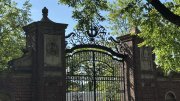Much has been made of the University’s multimillion-dollar investments in online education. But this remains very much a physical campus, investing to renovate the undergraduate Houses, create new core facilities like the Harvard Art Museums, and grow expansively in Allston.
Harvard spent $465 million on capital projects in the last fiscal year, and it’s easy to envision the pace ramping up. The $6.5-billion Harvard Campaign outlined at least $1.3 billion in donor support for such ventures—no doubt to be augmented by internal funds, endowment decapitalizations, and incremental borrowing.
Harvard clearly expects the campus experience to remain a global draw. Its facilities will likely be built to Harvard standards: high-quality construction, meant for long-term use, and designed to attain very high levels of operating and environmental/energy efficiency. All to the good.
But none of this comes cheap. Last fall, New York Times architecture critic Michael Kimmelman praised the Arcus Center for Social Justice Leadership, at Kalamazoo College, designed by Jeanne Gang, M.Arch. ’93, but noted “understandable grumbling about spending $500 a square foot…considering the dire circumstances of many of those Arcus intends to help.” What would he think (even allowing for differences in construction costs and in other elements of the plan) of the Kennedy School’s 77,000-square-foot expansion and campus reconfiguration—expected to cost three times as much per square foot? The work will rightly be funded entirely by gifts. But it is a lot of money, and there are many competing demands at the school (its campaign goal is $500 million) and elsewhere. That is something for University leaders to think about.
A bit more institutional transparency might help, too. The Kennedy School has described its project’s finances, but that is exceptional. Did the art museums cost $350 million? More? Who knows? House renovation expenses dribble out in the footnotes to the dean’s annual report. The Smith Campus Center and myriad Business School projects are anybody’s guess. More illumination might inhibit excessive capital-project ambitions somewhat. That could be useful for a fortunate community that is, nonetheless, watching expenses; enduring some internal turmoil to restrain employee-benefit costs; and taking overdue steps to fund depreciation for its 25 million square feet of existing facilities—a valuable discipline, but one bound to pinch future academic budgets. Better to build that understanding now, along with all the new buildings on the drawing boards.
~John S. Rosenberg, Editor








